Abstract
To assess the mechanisms of the insulin resistance in human obesity, we have determined, using a modification of the euglycemic glucose clamp technique, the shape of the in vivo insulin-glucose disposal dose-response curves in 7 control and 13 obese human subjects. Each subject had at least three euglycemic studies performed at insulin infusion rates of 15, 40, 120, 240, or 1,200 mU/M2/min. The glucose disposal rate was decreased in all obese subjects compared with controls (101 +/- 16 vs. 186 +/- 16 mg/M2/min) during the 40 mU/M2/min insulin infusion. The mean dose-response curve for the obese subjects was displaced to the right, i.e., the half-maximally effective insulin concentration was 270 +/- 27 microU/ml for the obese compared with 130 +/- 10 microU/ml for controls. In nine of the obese subjects, the dose-response curves were shifted to the right, and maximal glucose disposal rates (at a maximally effective insulin concentration) were markedly decreased, indicating both a receptor and a postreceptor defect. On the other hand, four obese patients had right-shifted dose-response curves but reached normal maximal glucose disposal rates, consistent with decreased insulin receptors as the only abnormality. When the individual data were analyzed, it was found that the lease hyperinsulinemic, least insulin-resistant patients displayed only the receptor defect, whereas those with the greatest hyperinsulinemia exhibited the largest post-receptor defect, suggesting a continuous spectrum of defects as one advances from mild to severe insulin resistance. When insulin's ability to suppress hepatic glucose output was assessed, hyperinsulinemia produced total suppresssion in all subjects. The dose-response curve for the obese subjects was shifted to the right, indicating a defect in insulin receptors. Insulin binding to isolated adipocytes obtained from the obese subjects was decreased, and a highly significant inverse linear relationship was demonstrated between insulin binding and the serum insulin concentration required for halfmaximal stimulation of glucose disposal. In conclusion: (a) decreased cellular insulin receptors contribute to the insulin resistance associated with human obesity in all subjects; (b) in the least hyperinsulinemic, insulin-resistant patients, decreased insulin receptors are the sole defect, whereas in the more hyperinsulinemic, insulin-resistant patients, the insulin resistance is the result of a combination of receptor and postreceptor abnormalities; (c) all obese patients were insensitive to insulin's suppressive effects on hepatic glucose output; this was entirely the result of decreased insulin receptors; no postreceptor defect in this insulin effect was demonstrated.
Full text
PDF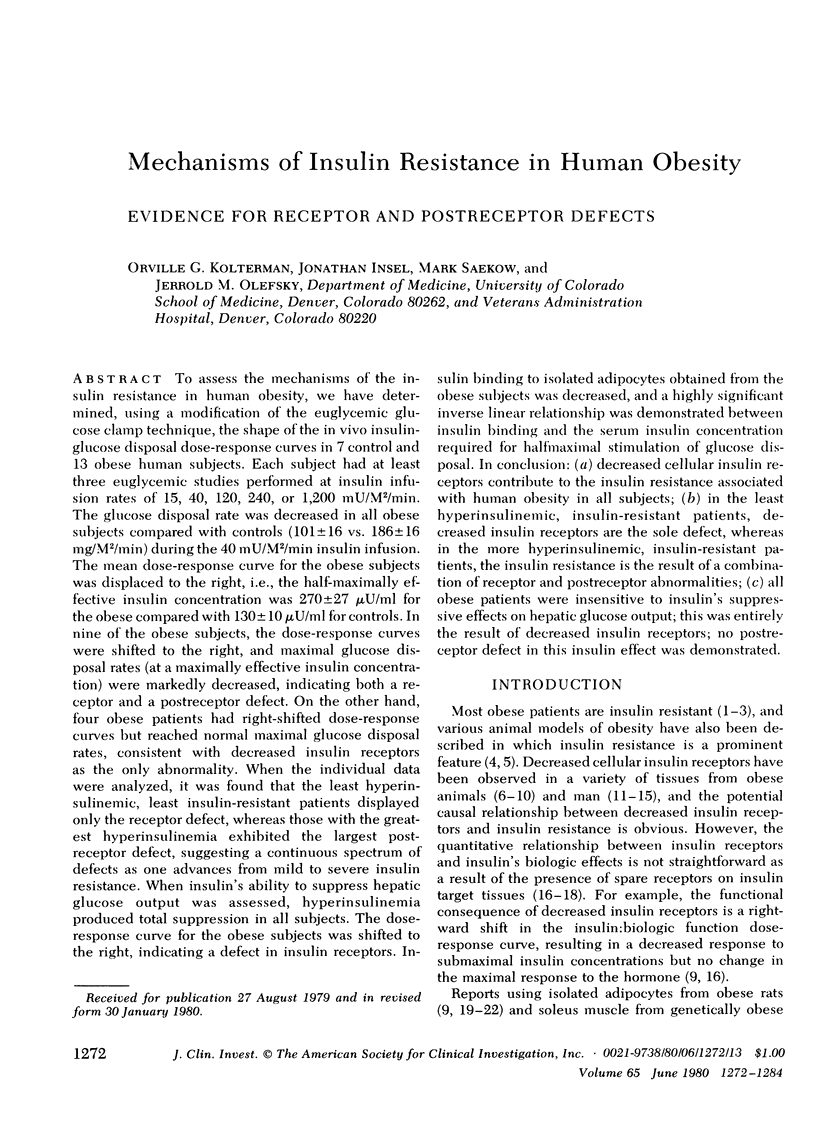
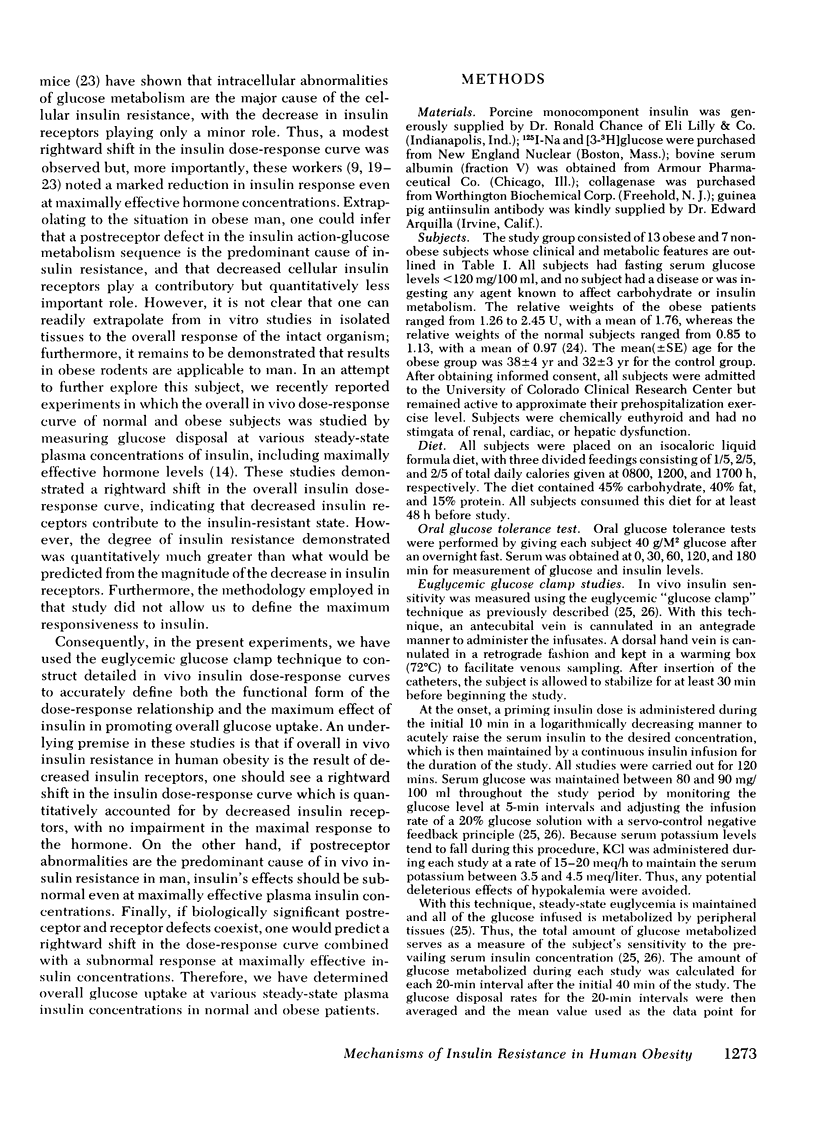
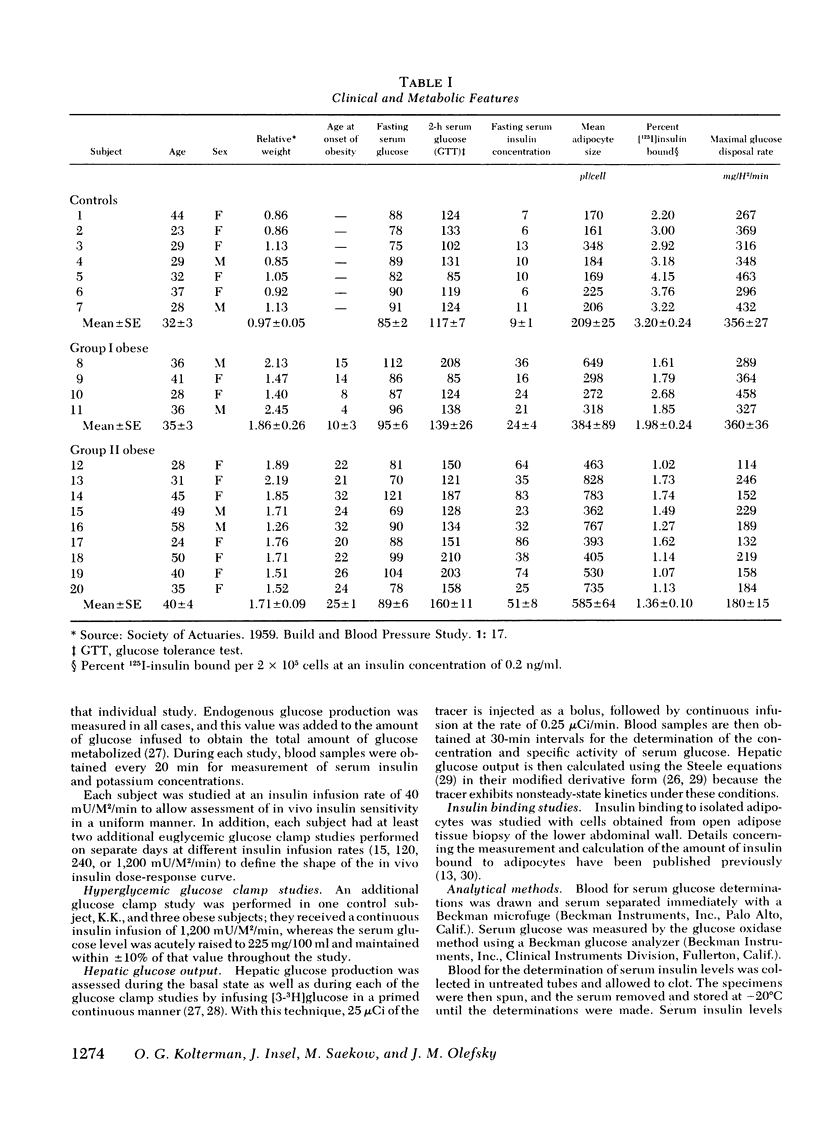
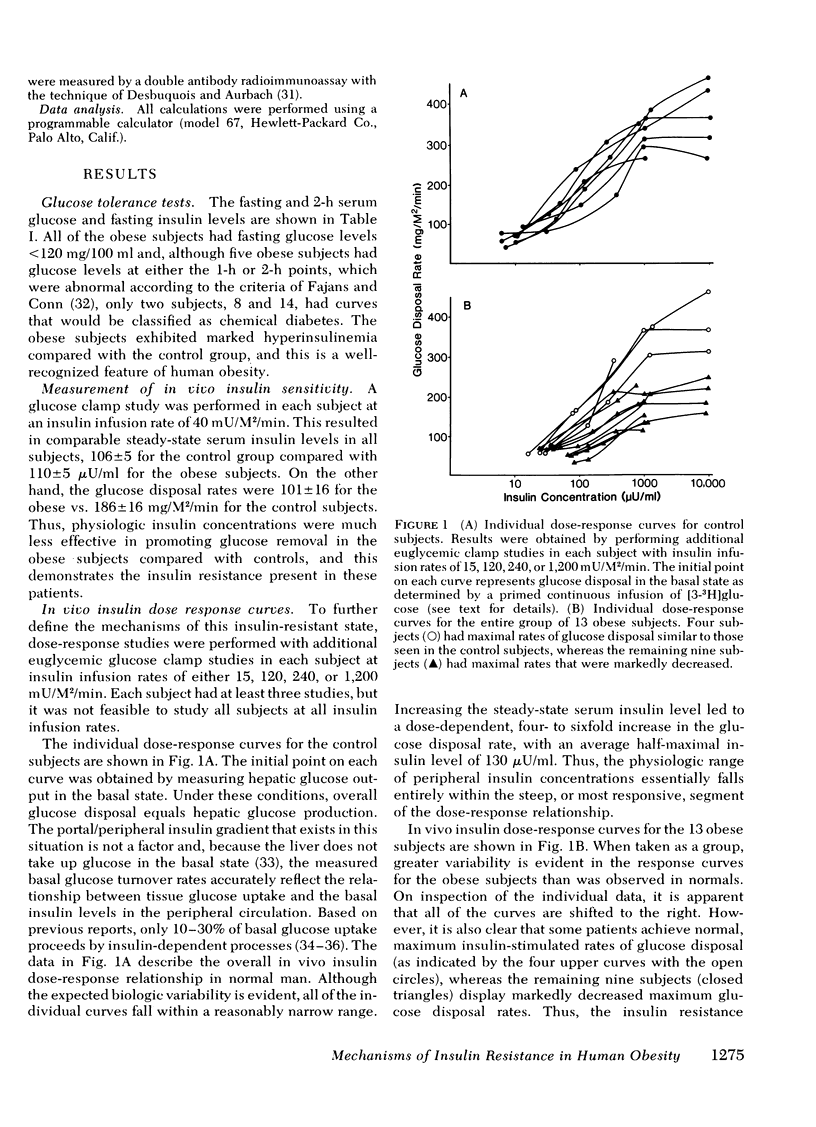
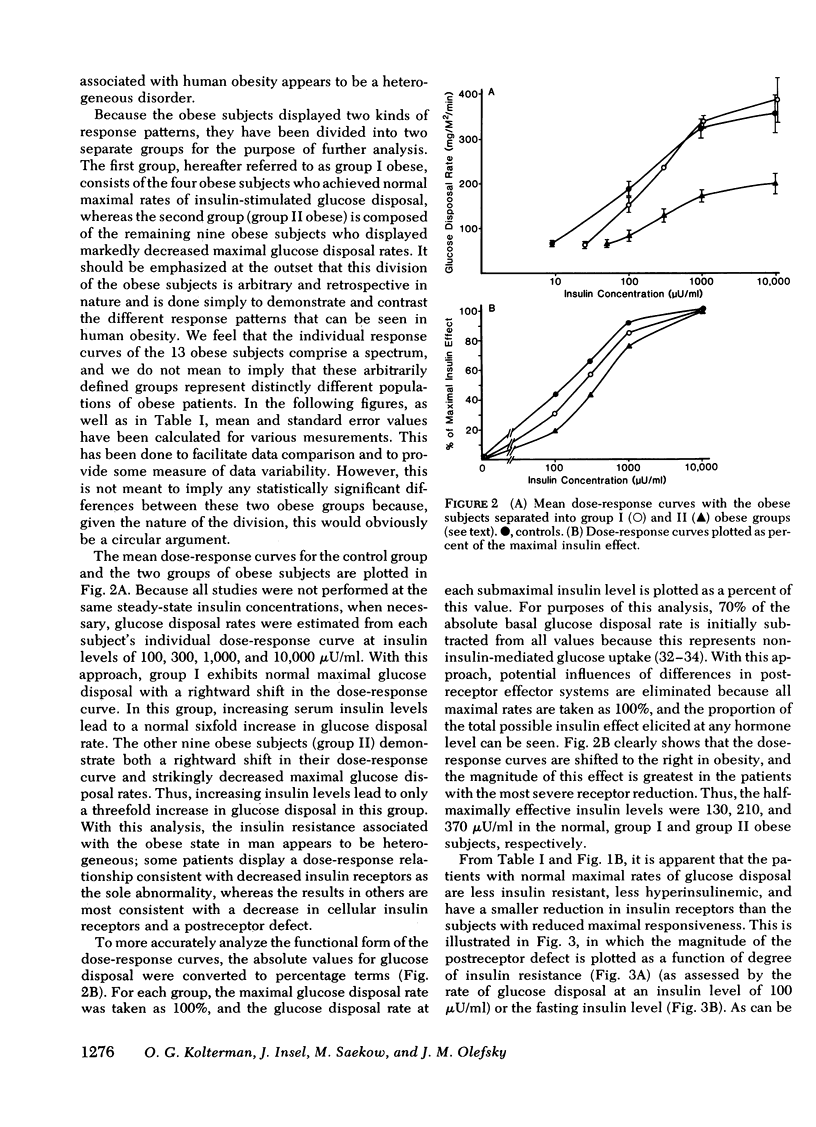
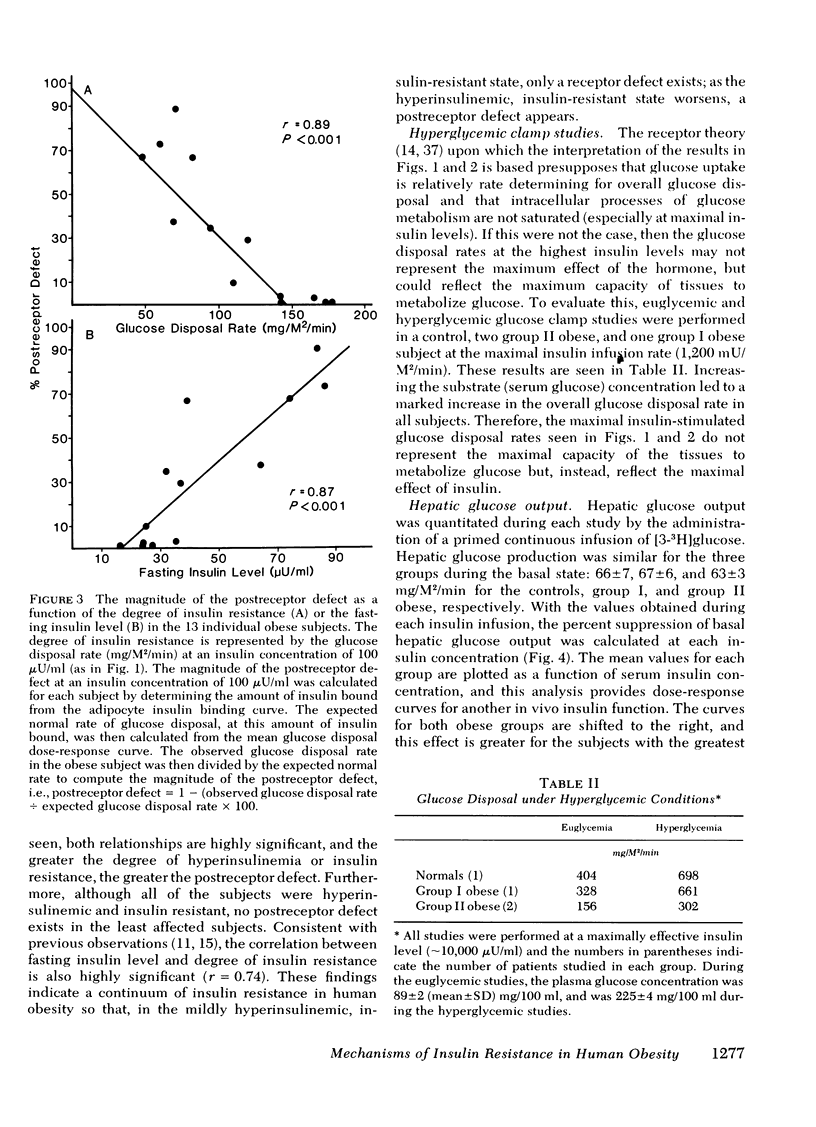
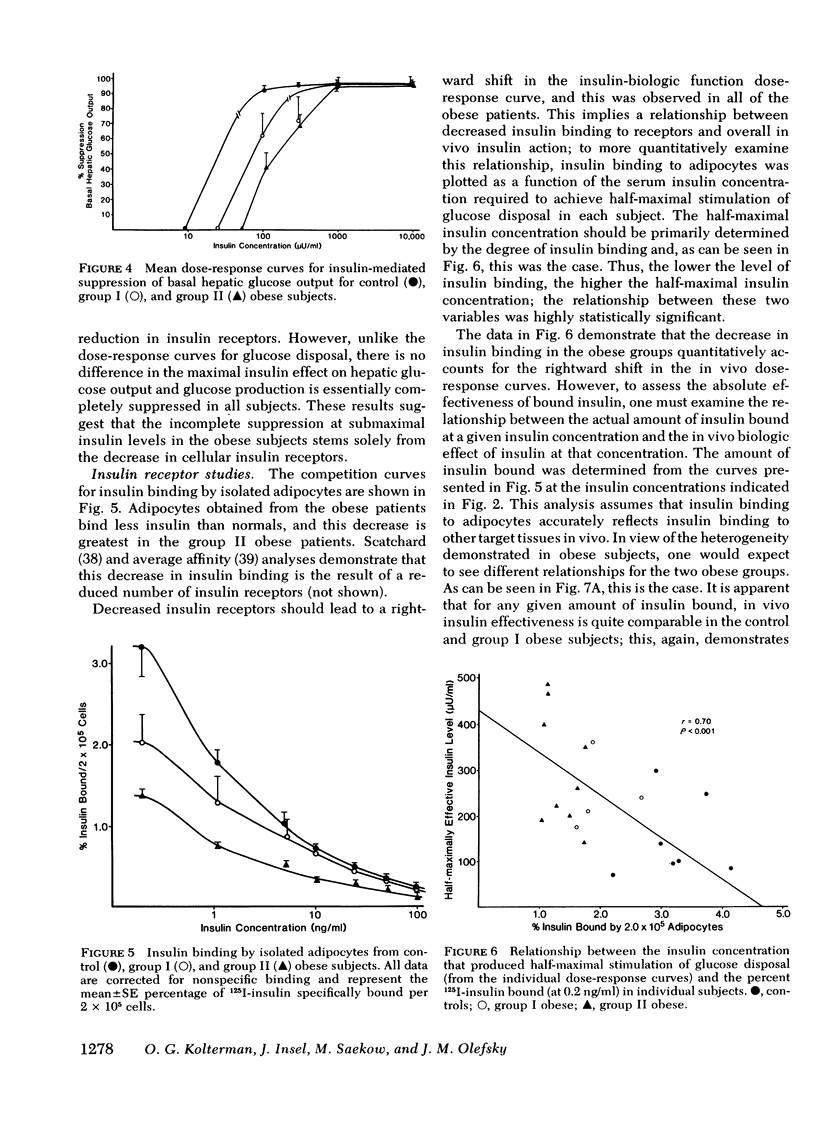

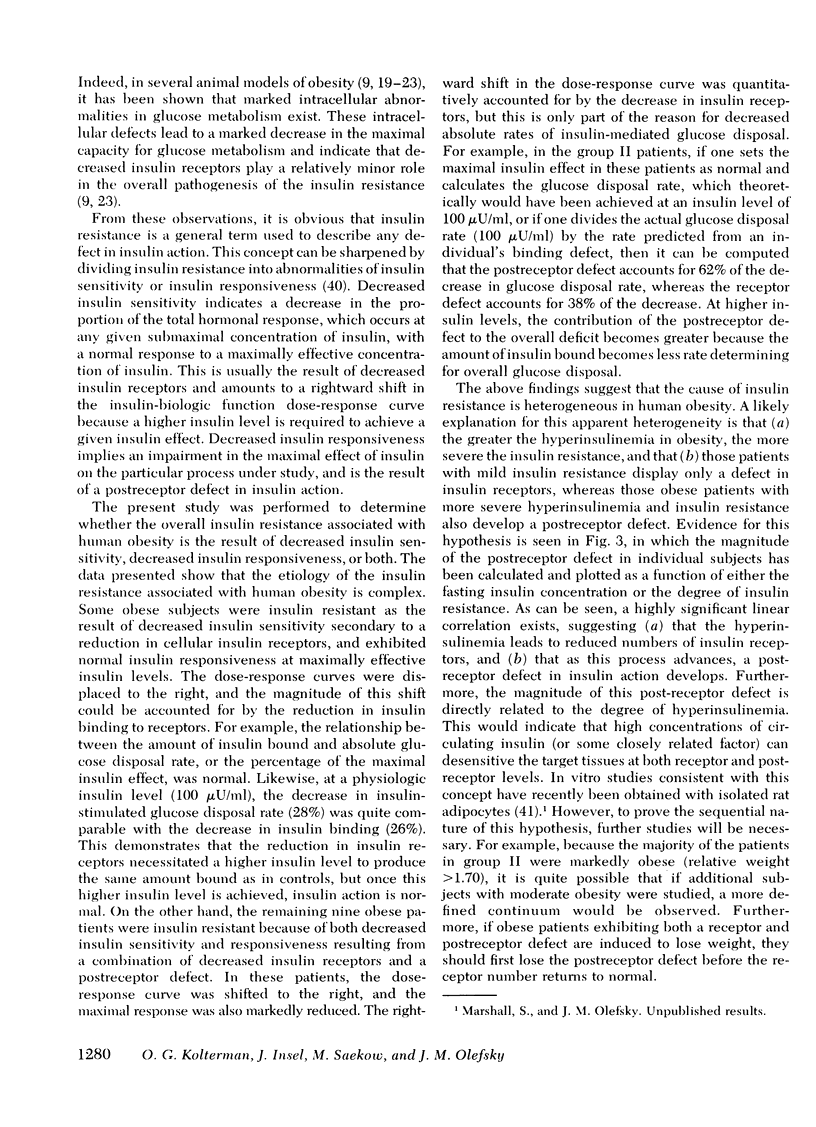
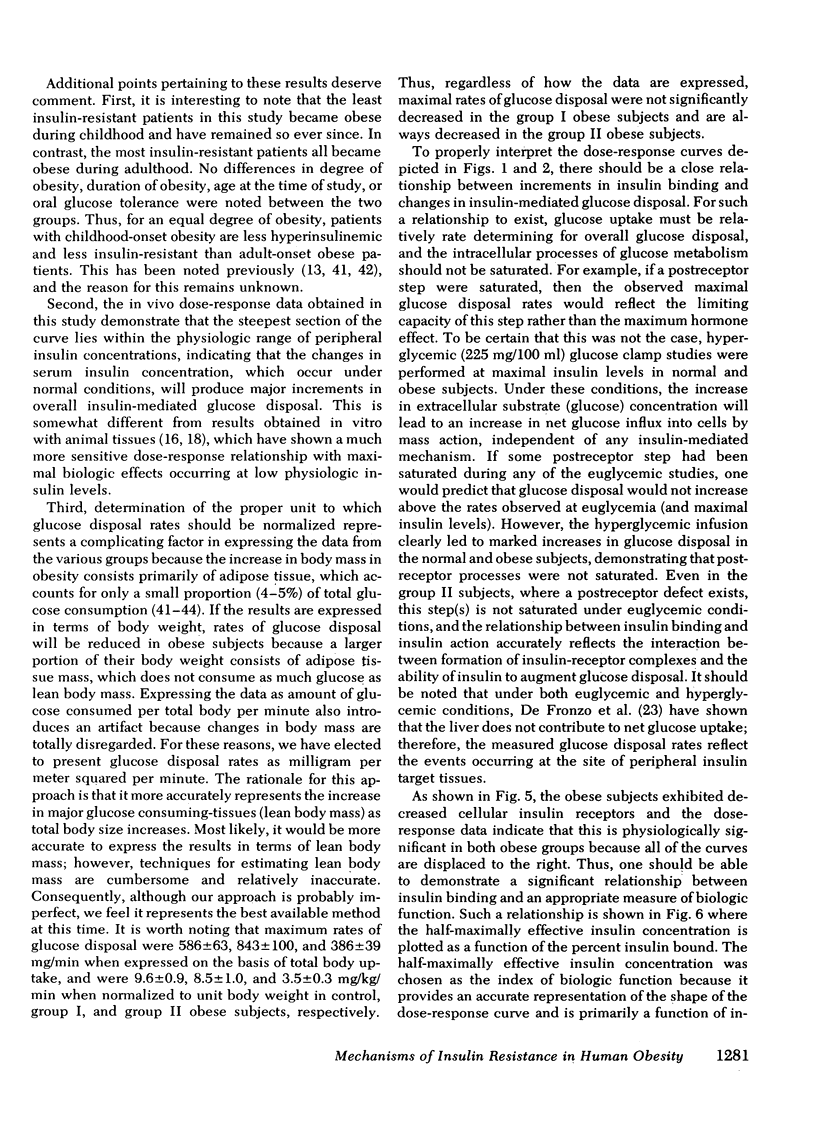
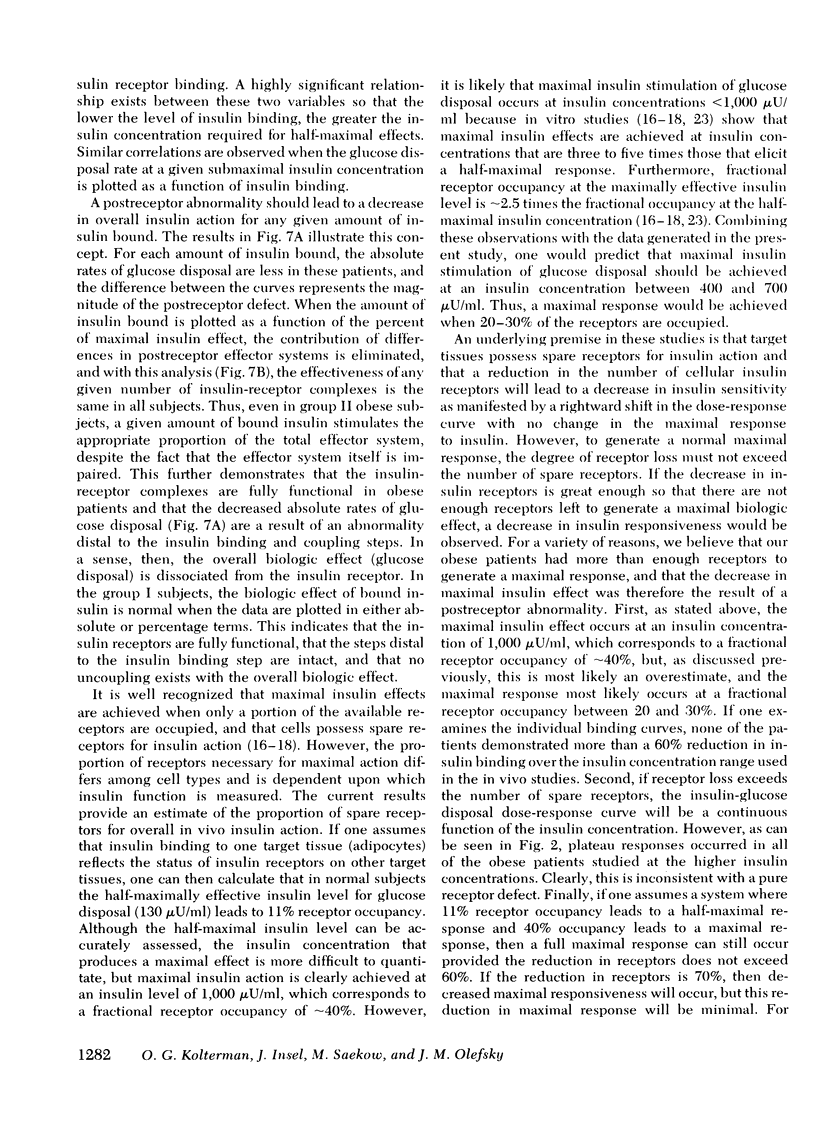
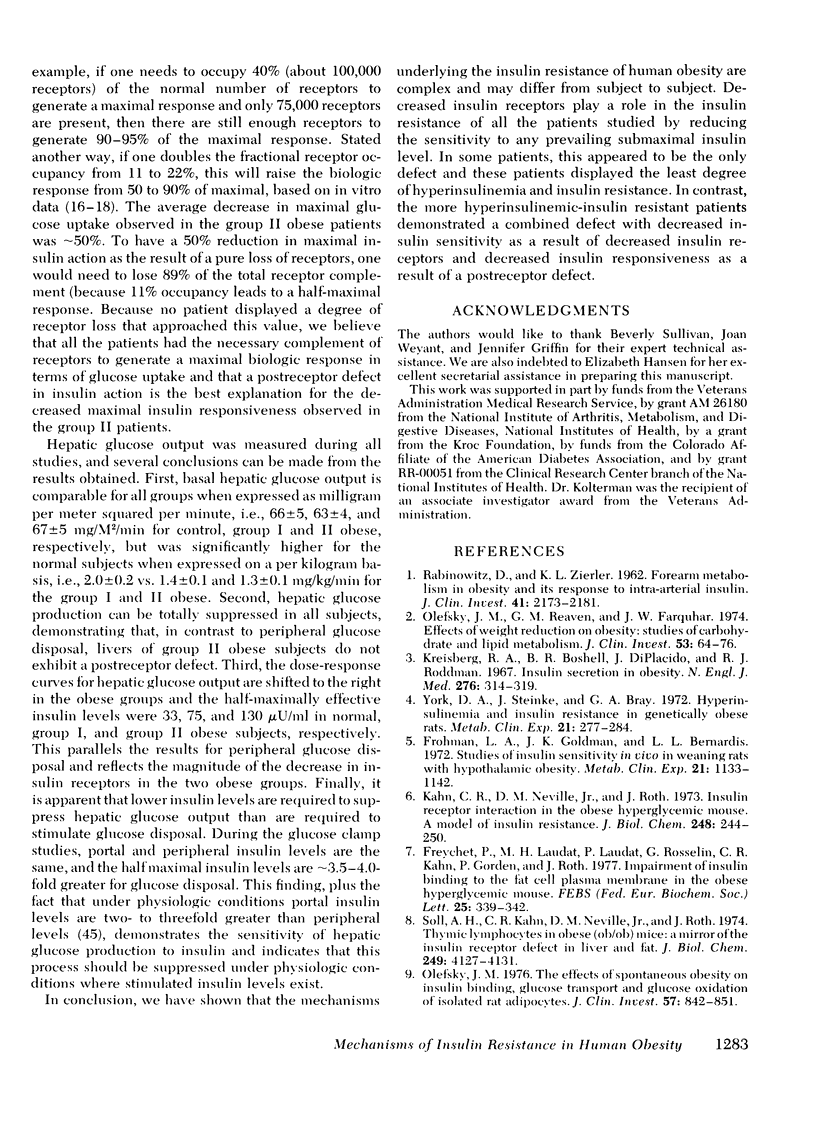
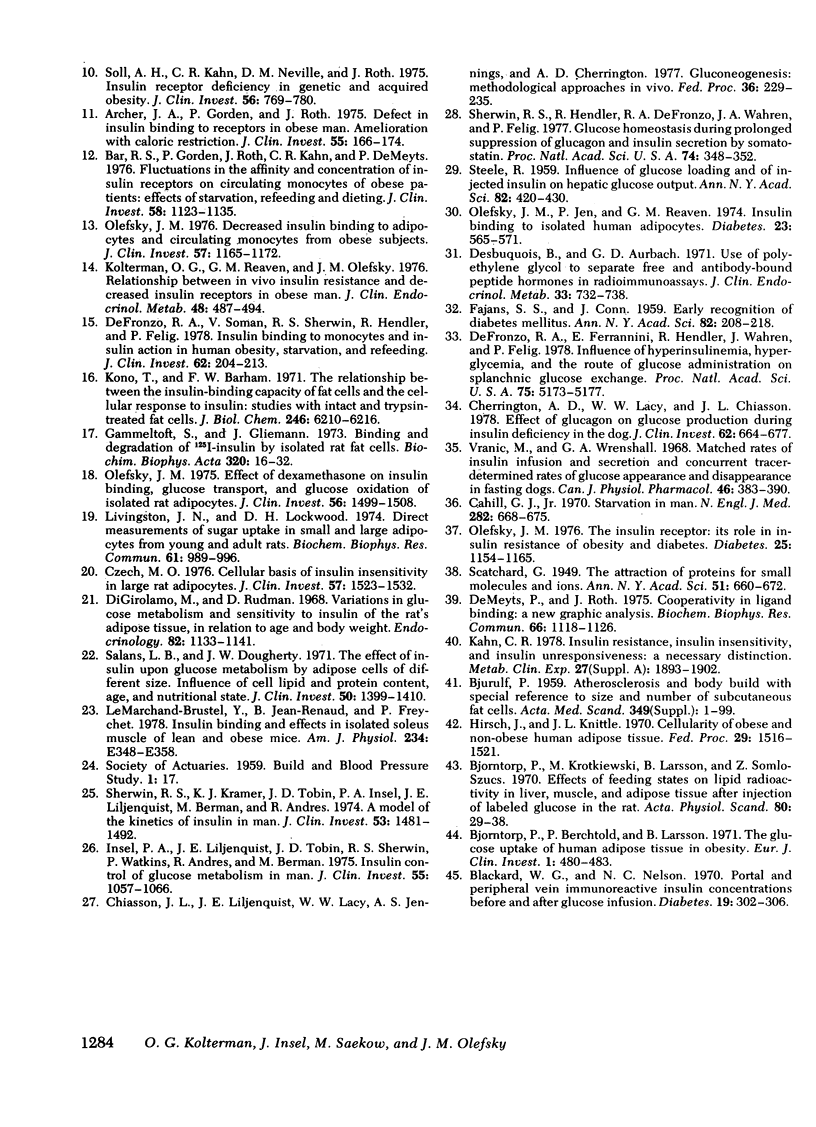
Selected References
These references are in PubMed. This may not be the complete list of references from this article.
- Archer J. A., Gorden P., Roth J. Defect in insulin binding to receptors in obese man. Amelioration with calorie restriction. J Clin Invest. 1975 Jan;55(1):166–174. doi: 10.1172/JCI107907. [DOI] [PMC free article] [PubMed] [Google Scholar]
- BJURULF P. Atherosclerosis and body-build with special reference to size and number of subcutaneous fat cells. Acta Med Scand Suppl. 1959;349:1–99. [PubMed] [Google Scholar]
- Bar R. S., Gorden P., Roth J., Kahn C. R., De Meyts P. Fluctuations in the affinity and concentration of insulin receptors on circulating monocytes of obese patients: effects of starvation, refeeding, and dieting. J Clin Invest. 1976 Nov;58(5):1123–1135. doi: 10.1172/JCI108565. [DOI] [PMC free article] [PubMed] [Google Scholar]
- Björntorp P., Berchtold P., Holm J., Larsson B. The glucose uptake of human adipose tissue in obesity. Eur J Clin Invest. 1971 Sep;1(6):480–485. doi: 10.1111/j.1365-2362.1971.tb00559.x. [DOI] [PubMed] [Google Scholar]
- Björntorp P., Krotkiewski M., Larsson B., Somlo-Szücs Z. Effects of feeding states on lipid radioactivity in liver, muscle and adipose tissue after injection of labelled glucose in the rat. Acta Physiol Scand. 1970 Sep;80(1):29–38. doi: 10.1111/j.1748-1716.1970.tb04766.x. [DOI] [PubMed] [Google Scholar]
- Blackard W. G., Nelson N. C. Portal and peripheral vein immunoreactive insulin concentrations before and after glucose infusion. Diabetes. 1970 May;19(5):302–306. doi: 10.2337/diab.19.5.302. [DOI] [PubMed] [Google Scholar]
- Cahill G. F., Jr Starvation in man. N Engl J Med. 1970 Mar 19;282(12):668–675. doi: 10.1056/NEJM197003192821209. [DOI] [PubMed] [Google Scholar]
- Cherrington A. D., Lacy W. W., Chiasson J. L. Effect of glucagon on glucose production during insulin deficiency in the dog. J Clin Invest. 1978 Sep;62(3):664–677. doi: 10.1172/JCI109174. [DOI] [PMC free article] [PubMed] [Google Scholar]
- Chiasson J. L., Liljenquist J. E., Lacy W. W., Jennings A. S., Cherrington A. D. Gluconeogenesis: methodological approaches in vivo. Fed Proc. 1977 Feb;36(2):229–235. [PubMed] [Google Scholar]
- Czech M. P. Cellular basis of insulin insensitivity in large rat adipocytes. J Clin Invest. 1976 Jun;57(6):1523–1532. doi: 10.1172/JCI108422. [DOI] [PMC free article] [PubMed] [Google Scholar]
- De Meyts P., Roth J. Cooperativity in ligand binding: a new graphic analysis. Biochem Biophys Res Commun. 1975 Oct 27;66(4):1118–1126. doi: 10.1016/0006-291x(75)90473-8. [DOI] [PubMed] [Google Scholar]
- DeFronzo R. A., Ferrannini E., Hendler R., Wahren J., Felig P. Influence of hyperinsulinemia, hyperglycemia, and the route of glucose administration on splanchnic glucose exchange. Proc Natl Acad Sci U S A. 1978 Oct;75(10):5173–5177. doi: 10.1073/pnas.75.10.5173. [DOI] [PMC free article] [PubMed] [Google Scholar]
- DeFronzo R. A., Soman V., Sherwin R. S., Hendler R., Felig P. Insulin binding to monocytes and insulin action in human obesity, starvation, and refeeding. J Clin Invest. 1978 Jul;62(1):204–213. doi: 10.1172/JCI109108. [DOI] [PMC free article] [PubMed] [Google Scholar] [Retracted]
- Desbuquois B., Aurbach G. D. Use of polyethylene glycol to separate free and antibody-bound peptide hormones in radioimmunoassays. J Clin Endocrinol Metab. 1971 Nov;33(5):732–738. doi: 10.1210/jcem-33-5-732. [DOI] [PubMed] [Google Scholar]
- Di Girolamo M., Rudman D. Variations in glucose metabolism and sensitivity to insulin of the rat's adipose tissue, in relation to age and body weight. Endocrinology. 1968 Jun;82(6):1133–1141. doi: 10.1210/endo-82-6-1133. [DOI] [PubMed] [Google Scholar]
- FAJANS S. S., CONN J. W. The early recognition of diabetes mellitus. Ann N Y Acad Sci. 1959 Sep 25;82:208–218. doi: 10.1111/j.1749-6632.1959.tb44901.x. [DOI] [PubMed] [Google Scholar]
- Freychet P., Laudat M. H., Laudat P., Rosselin G., Kahn C. R., Gorden P., Roth J. Impairment of insulin binding to the fat cell plasma membrane in the obese hyperglycemic mouse. FEBS Lett. 1972 Sep 15;25(2):339–342. doi: 10.1016/0014-5793(72)80519-2. [DOI] [PubMed] [Google Scholar]
- Gammeltoft S., Gliemann J. Binding and degradation of 125I-labelled insulin by isolated rat fat cells. Biochim Biophys Acta. 1973 Aug 17;320(1):16–32. doi: 10.1016/0304-4165(73)90161-x. [DOI] [PubMed] [Google Scholar]
- Hirsch J., Knittle J. L. Cellularity of obese and nonobese human adipose tissue. Fed Proc. 1970 Jul-Aug;29(4):1516–1521. [PubMed] [Google Scholar]
- Insel P. A., Liljenquist J. E., Tobin J. D., Sherwin R. S., Watkins P., Andres R., Berman M. Insulin control of glucose metabolism in man: a new kinetic analysis. J Clin Invest. 1975 May;55(5):1057–1066. doi: 10.1172/JCI108006. [DOI] [PMC free article] [PubMed] [Google Scholar]
- Kahn C. R. Insulin resistance, insulin insensitivity, and insulin unresponsiveness: a necessary distinction. Metabolism. 1978 Dec;27(12 Suppl 2):1893–1902. doi: 10.1016/s0026-0495(78)80007-9. [DOI] [PubMed] [Google Scholar]
- Kolterman O. G., Reaven G. M., Olefsky J. M. Relationship between in vivo insulin resistance and decreased insulin receptors in obese man. J Clin Endocrinol Metab. 1979 Mar;48(3):487–494. doi: 10.1210/jcem-48-3-487. [DOI] [PubMed] [Google Scholar]
- Kono T., Barham F. W. The relationship between the insulin-binding capacity of fat cells and the cellular response to insulin. Studies with intact and trypsin-treated fat cells. J Biol Chem. 1971 Oct 25;246(20):6210–6216. [PubMed] [Google Scholar]
- Kreisberg R. A., Boshell B. R., DiPlacido J., Roddam R. F. Insulin secretion in obesity. N Engl J Med. 1967 Feb 9;276(6):314–319. doi: 10.1056/NEJM196702092760603. [DOI] [PubMed] [Google Scholar]
- Le Marchand-Brustel Y., Jeanrenaud B., Freychet P. Insulin binding and effects in isolated soleus muscle of lean and obese mice. Am J Physiol. 1978 Apr;234(4):E348–E358. doi: 10.1152/ajpendo.1978.234.4.E348. [DOI] [PubMed] [Google Scholar]
- Livingston J. N., Lockwood D. H. Direct measurements of sugar uptake in small and large adipocytes from young and adult rats. Biochem Biophys Res Commun. 1974 Dec 11;61(3):989–996. doi: 10.1016/0006-291x(74)90253-8. [DOI] [PubMed] [Google Scholar]
- Olefsky J. M. Decreased insulin binding to adipocytes and circulating monocytes from obese subjects. J Clin Invest. 1976 May;57(5):1165–1172. doi: 10.1172/JCI108384. [DOI] [PMC free article] [PubMed] [Google Scholar]
- Olefsky J. M. Effect of dexamethasone on insulin binding, glucose transport, and glucose oxidation of isolated rat adipocytes. J Clin Invest. 1975 Dec;56(6):1499–1508. doi: 10.1172/JCI108231. [DOI] [PMC free article] [PubMed] [Google Scholar]
- Olefsky J. M., Jen P., Reaven G. M., Alto P. Insulin binding to isolated human adipocytes. Diabetes. 1974 Jul;23(7):565–571. doi: 10.2337/diab.23.7.565. [DOI] [PubMed] [Google Scholar]
- Olefsky J. M. The effects of spontaneous obesity on insulin binding, glucose transport, and glucose oxidation of isolated rat adipocytes. J Clin Invest. 1976 Apr;57(4):842–851. doi: 10.1172/JCI108360. [DOI] [PMC free article] [PubMed] [Google Scholar]
- Olefsky J. M. The insulin receptor: its role in insulin resistance of obesity and diabetes. Diabetes. 1976 Dec;25(12):1154–1162. doi: 10.2337/diab.25.12.1154. [DOI] [PubMed] [Google Scholar]
- Olefsky J., Reaven G. M., Farquhar J. W. Effects of weight reduction on obesity. Studies of lipid and carbohydrate metabolism in normal and hyperlipoproteinemic subjects. J Clin Invest. 1974 Jan;53(1):64–76. doi: 10.1172/JCI107560. [DOI] [PMC free article] [PubMed] [Google Scholar]
- RABINOWITZ D., ZIERLER K. L. Forearm metabolism in obesity and its response to intra-arterial insulin. Characterization of insulin resistance and evidence for adaptive hyperinsulinism. J Clin Invest. 1962 Dec;41:2173–2181. doi: 10.1172/JCI104676. [DOI] [PMC free article] [PubMed] [Google Scholar]
- STEELE R. Influences of glucose loading and of injected insulin on hepatic glucose output. Ann N Y Acad Sci. 1959 Sep 25;82:420–430. doi: 10.1111/j.1749-6632.1959.tb44923.x. [DOI] [PubMed] [Google Scholar]
- Salans L. B., Dougherty J. W. The effect of insulin upon glucose metabolism by adipose cells of different size. Influence of cell lipid and protein content, age, and nutritional state. J Clin Invest. 1971 Jul;50(7):1399–1410. doi: 10.1172/JCI106623. [DOI] [PMC free article] [PubMed] [Google Scholar]
- Sherwin R. S., Hendler R., DeFronzo R., Wahren J., Felic P. Glucose homeostasis during prolonged suppression of glucagon and insulin secretion by somatostatin. Proc Natl Acad Sci U S A. 1977 Jan;74(1):348–352. doi: 10.1073/pnas.74.1.348. [DOI] [PMC free article] [PubMed] [Google Scholar]
- Sherwin R. S., Kramer K. J., Tobin J. D., Insel P. A., Liljenquist J. E., Berman M., Andres R. A model of the kinetics of insulin in man. J Clin Invest. 1974 May;53(5):1481–1492. doi: 10.1172/JCI107697. [DOI] [PMC free article] [PubMed] [Google Scholar]
- Soli A. H., Kahn C. R., Neville D. M., Jr, Roth J. Insulin receptor deficiency in genetic and acquired obesity. J Clin Invest. 1975 Oct;56(4):769–780. doi: 10.1172/JCI108155. [DOI] [PMC free article] [PubMed] [Google Scholar]
- Vranic M., Wrenshall G. A. Matched rates of insulin infusion and secretion and concurrent tracer-determined rates of glucose appearance and disappearance in fasting dogs. Can J Physiol Pharmacol. 1968 May;46(3):383–390. doi: 10.1139/y68-058. [DOI] [PubMed] [Google Scholar]
- York D. A., Steinke J., Bray G. A. Hyperinsulinemia and insulin resistance in genetically obese rats. Metabolism. 1972 Apr;21(4):277–284. doi: 10.1016/0026-0495(72)90070-4. [DOI] [PubMed] [Google Scholar]


